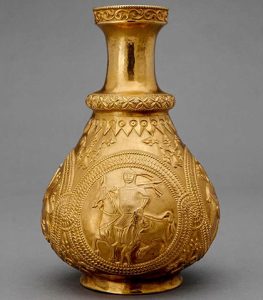Research discovers ancient migrant race
New scientific research has identified an enigmatic race of warrior horsemen as the world’s first long-distance migrants.
A research team of geneticists, archaeologists and historians from universities around the world have identified the Avars, mysterious horse-riding warriors who helped hasten the end of the Roman Empire, as the first migrant race in history
 The Avars ruled much of Central and Eastern Europe for almost 250 years. It was always suspected that they came from Central Asia in the sixth century CE, but there was considerable debate about this.
The Avars ruled much of Central and Eastern Europe for almost 250 years. It was always suspected that they came from Central Asia in the sixth century CE, but there was considerable debate about this.
Now researchers have obtained and studied the first ancient genomes from important Avar elite sites discovered in modern-day Hungary.
These have yielded direct genetic evidence for one of the largest and most rapid long-distance migrations in ancient human history.
In the 560s, the Avars established an empire that lasted more than 200 years, centred in the Carpathian Basin.
Knowledge about them comes mainly from the historical sources of their enemies, the Byzantines, who wondered about the origin of the fearsome Avar warriors after their sudden appearance in Europe.
Two hundred years later the Avars disappeared without trace and scholars have been searching for their origins ever since.
The new, archaeological and genetic evidence reveals the Avars were migrants from Mongolia—and their migration was, up to that point, the fastest long-distance movement in human history.
The Avars had no written records but grave relics and historical accounts suggest they dominated the plains of modern-day Hungary soon after their arrival in Europe about 1500 years ago.
They buried their elites in massive mounds, surrounded by weapons, and finely decorated gold and silver ornaments and often horses and riding equipment.
It was these mounds that gave up the vital clues to the Avars’ origins.
A team from universities in Germany, the US, Hungary, Korea and Austria extracted ancient DNA from the skeletons of dozens of high-status people from sites in modern-day Hungary.
The samples matched most closely with samples from graves from the sixth century in modern day Mongolia.
The researchers found the first Avar burials were a near-identical match for an individual buried just a few decades earlier in eastern Mongolia, showing the first Avars in Europe had probably made a journey of about 7,000 kilometres.
The researchers say the Avars used their nomadic lifestyle, trade networks stretching across the vast steppe, as well as their horse-riding prowess to move quickly across the grasslands of Eurasia.
After arriving on the outskirts of the Roman Empire, the Avars pushed into central Europe, conquering the plains along the Danube River between modern-day Vienna and Belgrade, and even besieging Constantinople, now Istanbul, in 623 C.E.
They were finally defeated by the Frankish king Charlemagne – whose bigger, better army destroyed their capital and eventually united most of Europe for the first time in centuries – in the late 700s.
The research shows the Avars moved from Mongolia to Hungary in a much larger group than just a band of warriors – there were wives and children present and no evidence of inbreeding. This means the group was probably tens of thousands strong.
The Avars’ ultimate fate after their defeat the hands of Charlemagne is uncertain. Their genetic signature dwindled to almost nothing in the regions they once ruled.












